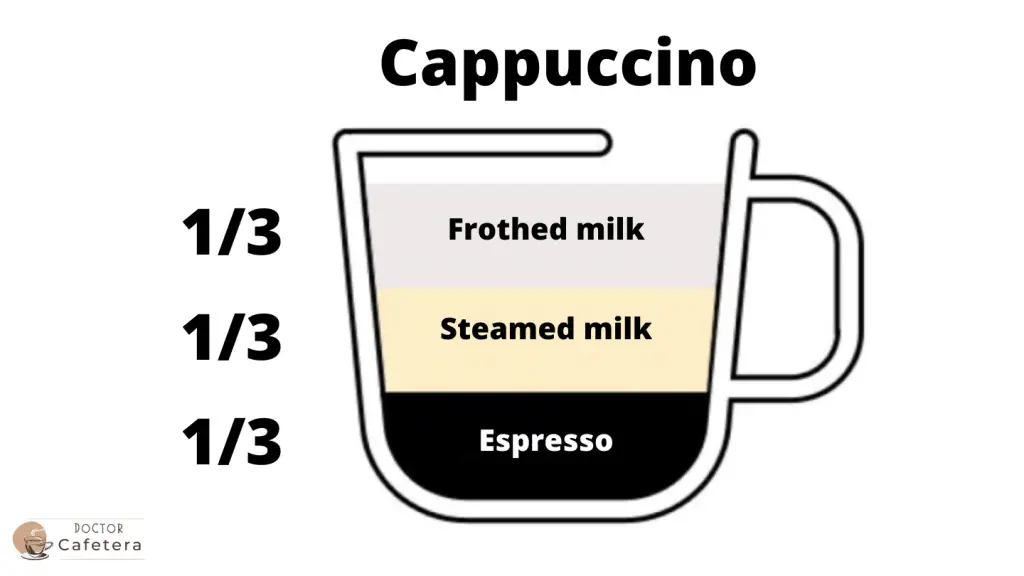I confess that my favorite coffee drink is cappuccino, and when I combine it with vegetable milk such as soy, oat, or almond, I take it to a higher level. I get all the coffee’s flavor mixed with the vegetable milk’s naturalness. But then the question arises: does cappuccino have caffeine?
As it is a coffee drink mixed with milk, its flavor is not as strong as an espresso or an Americano, so it seems it does not contain caffeine or at least less caffeine than coffee drinks without milk.
Cappuccinos are prepared from a single or double espresso, so even if mixed with milk, the drink contains the same caffeine as an espresso. Depending on the amount of espresso, a cappuccino has between 65 and 130 milligrams of caffeine.
How much coffee is in a cappuccino?
We already know that a cappuccino is made by mixing coffee and milk in different quantities. So before studying the amount of caffeine in a cappuccino, we need to understand what type of coffee is and how much it is in it.
A cappuccino is divided into three equal parts, even if only two ingredients are used: coffee and milk. A first part (1/3) of espresso coffee, a second part (1/3) of steamed milk, and a third part (1/3) of milk foam.
In short, two parts of milk for each part of espresso coffee. How much espresso coffee is in a cappuccino depends on your taste, but the more coffee there is, the more milk will be added. Remember that a cappuccino always respects the proportion 1/3+1/3+1/3.
Related:
How much caffeine is in a cappuccino?
Let’s suppose that we prepare the smallest cappuccino possible. If we follow the ideal cappuccino ratio, this coffee drink with milk would have a simple espresso (30 ml of coffee) and 60 ml of milk.
Depending on different factors, such as the bean or roast type, a simple espresso has between 60 and 80 mg of caffeine. For this reason, a cappuccino with a single espresso contains between 60 and 80 mg of caffeine. The caffeine could reach 120 – 160 mg if we prepare a larger cappuccino with two espressos.
The type of coffee beans will condition the caffeine of the cappuccino
We have already established that caffeine determines the amount of caffeine in a cappuccino in the espresso you put in your drink. So controlling the amount of caffeine in the espresso means controlling the amount in the cappuccino.
We have already talked on other occasions about the difference between the two main types of coffee beans; Arabica and Robusta. The Arabica is the most coveted and widespread and has less caffeine than the Robusta. In the following table, you can see their main differences:
| BEAN | Arabica | Robusta |
| Form | Elongated | Rounded |
| Oils | 18% | 8% |
| Sugars | 8% | 5% |
| Caffeine | 1.5% | 3% |
If you prepare your cappuccinos at home, you can reduce the amount of caffeine in your drink by changing from Robusta to Arabica beans. If you are away from home, you are at the mercy of the bean used in each coffee shop, which will often be Robusta.
Most coffee shops use Robusta, whose more bitter taste and reduced amount of sugars and oils offer fuller-bodied and creamier espressos. So it is most likely that drinking your cappuccino in a coffee shop will have as much caffeine as possible.
Is there such a thing as a decaffeinated cappuccino?
Following the above logic, a decaffeinated cappuccino will contain decaffeinated coffee. Therefore, to prepare a caffeine-free cappuccino, you must prepare espresso using decaffeinated coffee.
Decaffeinated coffee has had a very bad reputation for many years; however, every day, more and more people demand it, and the manufacturers take it into account. For this reason, decaffeinated coffee has recently become much more similar to standard coffee.
If you prepare your cappuccinos at home, you should only use decaffeinated coffee to prepare the espresso. Whereas, if you are in a coffee shop, you should ask the barista to use decaffeinated beans when preparing your cappuccino.
Are there decaffeinated cappuccino pods?
No official brand of coffee pod machines has released decaffeinated cappuccino pods yet, and they may never do so. I imagine that the market for decaffeinated coffee must be very small, so it is not profitable to create such decaffeinated beverages.
However, all brands have decaffeinated espresso pods. You must prepare an espresso, froth the milk at home, and create a caffeine-free cappuccino pod.
How many cappuccinos can you drink in a day?
There seems to be a worldwide consensus at the level of the health departments of the different governments, where 400 mg is the maximum daily amount that a healthy adult can ingest.
If we translate this number to the amount of caffeine in a cappuccino (60-80mg), you should not drink more than 5 or 6 drinks with a single espresso. If you drink cappuccinos with double espresso, you should not drink more than 2 or 3 units.
